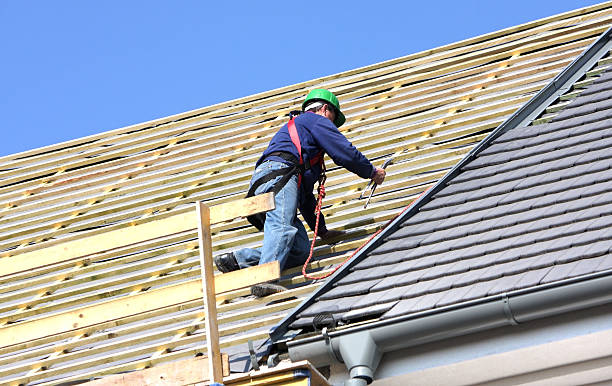Roofing is a critical aspect of home maintenance and construction, requiring careful attention to safety protocols to prevent accidents and ensure a successful project. Whether you’re a homeowner planning a DIY roof repair or a contractor managing roofing projects professionally, adhering to safety practices is paramount. This article outlines essential safety guidelines and best practices to promote a safe working environment on rooftops.

1. Understanding Roofing Risks
Roofing poses inherent risks due to height, steep angles, slippery surfaces, and exposure to weather elements. Common hazards include falls, electrical hazards, tool injuries, and material handling accidents. Recognizing these risks is crucial for implementing effective safety measures.
2. Safety Equipment and Gear
Proper safety equipment is essential for all individuals working on roofs:
- Personal Protective Equipment (PPE): Includes hard hats, non-slip footwear, safety harnesses, gloves, and eye protection.
- Fall Protection Systems: Use guardrails, safety nets, and personal fall arrest systems (PFAS) to prevent falls from heights.
- Ladders: Ensure stable, non-skid ladders with level placement and secure anchoring.
3. Preparation and Planning
Before starting any roofing work, thorough planning and preparation mitigate risks:
- Risk Assessment: Identify potential hazards and implement control measures.
- Weather Conditions: Avoid working during adverse weather conditions such as rain, wind, or ice.
- Tool Inspection: Ensure tools are in good condition, properly maintained, and suitable for the task.
4. Safe Work Practices
Implement safe practices to minimize risks and ensure efficient work progress:
- Team Communication: Maintain clear communication among team members to coordinate tasks and alert others of hazards.
- Work Area Safety: Keep the work area clean, organized, and free of debris to prevent slips and trips.
- Material Handling: Use proper lifting techniques and mechanical aids for heavy materials to avoid strain injuries.
5. Electrical Safety
Roofing projects often involve electrical components, necessitating precautions:
- Power Lines: Identify and avoid overhead power lines to prevent electrocution hazards.
- Ground Fault Circuit Interrupters (GFCIs): Use GFCI outlets for power tools to protect against electric shock in wet conditions.

6. Emergency Preparedness
Prepare for emergencies with proactive measures:
- First Aid: Have a fully stocked first aid kit readily accessible on-site.
- Emergency Contacts: Keep emergency contact numbers and procedures visible to all workers.
- Rescue Plan: Establish an emergency response plan for incidents such as falls or injuries.
7. Training and Certification
Ensure all workers are trained and certified in roofing safety protocols:
- Safety Training: Provide regular safety training sessions covering hazards, procedures, and equipment usage.
- Certifications: Certify workers in handling specific roofing materials and equipment safely.
8. Environmental Considerations
Consider environmental factors that may impact safety and project execution:
- Weather Monitoring: Monitor weather forecasts and adjust work schedules accordingly.
- Heat Stress: Provide adequate hydration, shade, and rest breaks during hot weather conditions.
9. Quality Materials and Installation
Use high-quality roofing materials and follow manufacturer guidelines for installation:
- Roof Inspections: Conduct thorough inspections before and after roofing projects to ensure structural integrity and safety.
- Proper Ventilation: Ensure roofs are properly ventilated to prevent moisture buildup and potential health hazards.

10. Legal and Regulatory Compliance
Adhere to local building codes, regulations, and safety standards:
- Permits: Obtain necessary permits for roofing projects and comply with inspection requirements.
- Insurance Coverage: Ensure adequate liability insurance coverage for workers and property protection.
Conclusion
Prioritizing roofing safety practices enhances efficiency, minimizes accidents, and protects both homeowners and contractors. By implementing comprehensive safety protocols, utilizing proper equipment, and promoting a culture of safety awareness, roofing projects can be completed safely and successfully. Whether you’re engaging in DIY roof repairs or managing professional roofing projects, investing in safety ensures a secure working environment and contributes to the longevity and integrity of residential and commercial properties.

